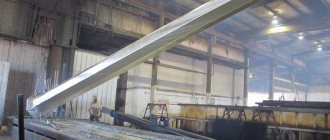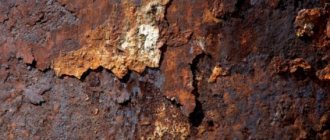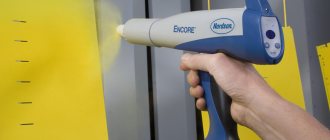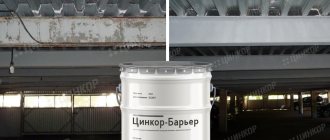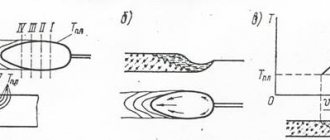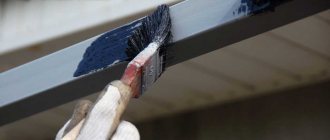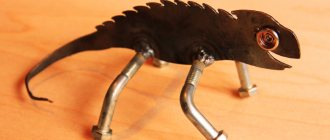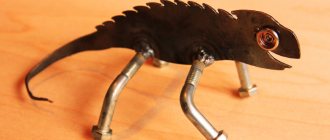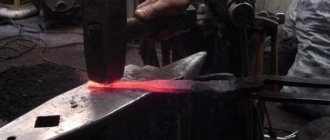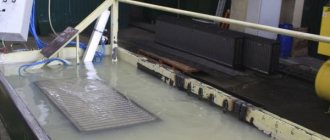Galvanol coating is a thin-film zinc coating that effectively protects ferrous metals from corrosion, has high protective properties and high adhesion to metal surfaces. Galvanol® coating is intended for anti-corrosion protection of external and internal surfaces of industrial equipment and metal structures.
ORDER
The GALVANOL coating provides both active (cathodic) and passive (barrier) protection against corrosion. This coating is also elastic, resistant to vibration, shock loads and abrasion, works in the temperature range from -60 C to +150 C (short term up to +180 -210 C when applying powder coatings). It is used in such areas as industrial and civil construction, transport construction, oil and gas complex, energy, railway facilities, port and hydraulic structures, motor transport.
Properties of zinc coating
- Forms a stable subdispersive Zn-Fe zone on the metal surface.
- It has the property of interlayer diffusion.
- Retains the function of surface self-preservation and self-healing throughout its entire service life.
- It is characterized by sufficient resistance to abrasive effects.
- The interatomic distance in the zinc layer is similar to the interatomic distance in the zinc layer deposited using the bath immersion process.
- It can be applied even in winter at temperatures from -35˚C.
- UV-stable, has a noble gray color.
Features of the technology
Paints used for cold galvanizing are various zinc-containing mixtures. The requirements for them, as well as for any zinc coatings obtained using various technologies, are regulated by GOST 9.305-84. Thus, this document states that cold galvanizing can be performed on any metal products and structures, except those made of high-strength steels or magnesium alloys.
In order to obtain a layer with high protective properties on a metal product or structure as a result of cold surface galvanizing, it is necessary to carefully prepare the surface to be treated.
Such preparation, according to GOST, consists of performing the following procedures.
- Coked areas, contaminants of various natures, salt residues, and damage caused by exposure to natural factors are removed from the treated surface.
- The metal is given the required level of roughness, for which abrasive blasting, water jet or hydrodynamic treatment can be used. In this way, oxidation products and rust can also be removed from the product.
- Final manual cleaning of the metal is carried out to remove welding spatter, sharp edges and burrs from it.
- Remove any remaining dust from the product using a jet of compressed air.
Cold galvanizing stages
In order for the galvanized layer to have good adhesion to the surface being treated, there should be no grease or oil stains on it. If such stains exist, they must be removed before cold galvanizing, for which hydrocarbon group solvents are used. GOST, in particular, stipulates the following requirements for the quality of preparation of the treated surface.
- The quantity and size of dust particles remaining on the surface of the product after dust removal must comply with the requirements of the ISO 8502-3 standard.
- The level of surface degreasing, which is checked using a luminescent technique, must comply with GOST 12.2.052.
- The degree of surface roughness, checked using a profilometer or comparator, must meet the requirements of ISO 8503-1.
Do-it-yourself cold galvanizing of a car body
After the quality of preparation for cold galvanizing has been checked, liquid zinc, a special mixture containing this metal, can be applied to the product. When using various paints or mixtures with a zinc component, you should pay attention to the air temperature at which manufacturers recommend using them. It should also be borne in mind that the temperature of the surface being treated must be at least 3° higher than the dew point. If you neglect this requirement, you may encounter the fact that moisture will condense on the surface of the workpiece, which will significantly deteriorate the characteristics of the applied coating.
To determine the dew point, which is required not only when carrying out cold galvanizing, you can use various measuring instruments, which include a hygrometer, thermometer, psychrometer or special measuring devices. The instrument readings obtained during such measurements are checked against the data in the reference tables. In this way, the dew point for a particular case is accurately determined.
Dew point dependence on temperature and relative humidity
Zinc paint can be applied in several layers. It is very important that each new layer is applied only after the previous one has dried to the degree specified by the manufacturer of the composition used. Each coat of paint for cold galvanizing should be applied as evenly as possible. Cold galvanizing, as mentioned above, can be performed using a pneumatic spray gun or using an airless method. As a rule, the latter method, which involves the use of rollers or brushes, is used in cases where the protective coating needs to be applied not to the entire surface of the product, but only to its individual sections.
The thickness of the formed protective layer, as well as the degree of its adhesion to the treated surface, must be checked, for which special measuring devices are used. In addition, visual inspection of the applied coating is carried out, which makes it possible to evaluate its decorative characteristics, as well as identify defects and poorly treated areas on it.
DIFFERENCE FROM ANALOGUES
Galvanizing, unlike zinc-rich coatings (cold galvanizing), does not require covering with finishing layers: thanks to a unique patented polymer that provides cathodic protection of zinc throughout its entire service life. It is used as an independent coating, by analogy with hot-dip galvanizing, however, if necessary, it can be used as a primer for various coatings and fire-retardant materials. Not destroyed by UV radiation.
Galvanizing, in contrast to hot-dip galvanizing, is used to protect large, hollow, thin-walled, overlap-welded products.
APPLICATION AND PURPOSE
Galvanizing is used to protect critical structures in all types of corrosive environments, including aggressive and highly aggressive (C5-I according to ISO 12944), providing a guaranteed protection period of 15 years or more with a layer thickness of 120 microns.
Galvanizing is used to protect building and technological metal structures in industrial and civil construction, agriculture, fuel and energy facilities, road and transport construction, and hydraulic structures.
Galvanizing is recommended for the repair and restoration of previously galvanized (including other methods) metal structures without dismantling.
Types of packaging of the protective composition "GALVANOL®"
Technical characteristics of the protective zinc composition "GALVANOL®"
| Consumption | 250 g/m2 with a thickness of 40 microns |
| Color | Gray matte, shade is not standardized |
| Appearance of dry coating | After drying, the film should be smooth, uniform, without foreign inclusions or smudges, matte |
| Solvent | Universal solvent (produced by NPTsAZ LLC), xylene, solvent |
| Viscosity upon application (20°C) | 60 s on a VZ-4 viscometer |
| Application | Application pressure | Nozzle | Number of layers |
| Top spray gun | 3 bar | 2.0-3.0 mm | 1-2 |
| Viability | Unlimited, dilute with solvent if necessary | ||
| Dry film thickness | 40-60 microns | ||
| Waiting time between coats | 10-40 min | ||
| Painting with protective and decorative coatings | Only organosoluble coatings, drying time before application to GALVANOL® is 4-6 hours | ||
| Drying time at temperature: -30°С -10°С +20°С +60°С | 50 min 40 min 20 min 10 min | ||
| Temperature resistance | from -60°С to +160°С (short-term up to 210°С when carrying out powder coating over the zinc layer) | ||
| Film elasticity when bending | 1 mm | ||
| Coating adhesion | 1 point | ||
| Mass fraction of non-volatile substances | 78% | ||
| Composition density at 20°C | 2500 kg/m3 | ||
| Rate of uniform open corrosion in seawater (according to polarization resistance method) | 0.020 mm/year | ||
| Grinding | It acquires a metallic sheen, but 5 microns of the coating are erased | ||
| Working conditions | from -35°С to +50°С | ||
| Packing | Eurobank 2 kg, 10 kg and 40 kg, aerosol can | ||
Galvanol. Galvanizing of metal and metal structures
Galvanizing of metal and metal structures is Galvanol®
Unlike cold galvanizing with zinc-rich coatings, the ZINCALING method does not require the application of finishing protective layers: a unique patented polymer provides cathodic protection of zinc throughout its entire service life. The coating can be used independently, as in the case of hot-dip galvanizing, and also, if necessary, can be used as a primer for various coatings and fire-retardant materials. Exposure to UV radiation does not destroy it.
However, unlike the hot method, galvanizing is used to protect large, hollow, thin-walled, overlap welded products.
PURPOSE AND SCOPE
The composition "GALVANOL®" forms a thin-film zinc coating, which has high anti-corrosion protective properties:
- protection against corrosion of ferrous metals, steel;
- corrosion protection of external and internal surfaces (equipment, metal structures);
- simultaneously carries out both passive (barrier) and active (cathodic) anti-corrosion protection of metals;
- has high elasticity, is not sensitive to shock and vibration, and is also resistant to abrasion.
- Operates at temperatures from -60°С to +150°С (when applying powder coatings, short-term changes up to +180–210°С are possible).
The protective composition "GALVANOL®" is used in various fields of construction: civil and industrial, transport, energy, oil and gas sector, at railway construction sites, port and hydraulic structures, and for galvanizing vehicles.
Metal products and structures coated with the “GALVANOL®” composition can be used in a wide variety of climatic regions, with different types of atmosphere and under different placement categories according to GOST 15150-69.
The resulting GALVANOL® coating is stable in fresh and sea water, as well as in aqueous solutions of various salts (pH = 6.0–10.0), in ethyl alcohol, and its aqueous solutions. It is allowed to use centralized cold water supply systems for anti-corrosion protection.
TECHNICAL SPECIFICATIONS
The protective composition "GALVANOL®" is liquid and ready for use. This is electrolytic zinc of a high degree of chemical purity, containing some volatile substances and their binding agents.
Can be stored for an unlimited period of time at temperatures from -40°C to +30°C, provided the original packaging is intact.
| Application | Application pressure | Nozzle | Number of layers |
| Top spray gun | 3 bar | 2.0-3.0 mm | 1-2 |
| Viability | Unlimited, if necessary, dilute with solvent Solvent (coal, petroleum), xylene | ||
| Dry film thickness | 40-60 microns | ||
| Waiting time between coats | 10-40 min | ||
| Mass fraction of non-volatile substances, % | at least 78 | ||
| Drying time at temperature: -30°С -10°С +20°С +60°С | 50 min 40 min 20 min 10 min | ||
| Temperature resistance | from -60°С to +160°С (short-term up to 210°С when carrying out powder coating over the zinc layer) | ||
| Film elasticity when bending | 1 mm | ||
| Coating adhesion | 1 point | ||
| Composition density at 20°C | 2400 kg/m3 | ||
| Viscosity upon application (20°C) | 60 s on a VZ-4 viscometer | ||
| Rate of uniform open corrosion in seawater | 0.02 mm/year | ||
| Grinding | It acquires a metallic sheen, but 5 microns of the coating are erased | ||
| Working conditions | from -35°С to +50°С | ||
| Consumption | 250 g/m2 with a thickness of 40 microns | ||
| Color | Gray matte, shade is not standardized | ||
COMPATIBLE WITH OTHER COATINGS
The protective composition "GALVANOL®" is fully compatible with solvent-soluble finishing coatings, epoxy, acrylic, urethane acrylic, polyurethane, chlorinated rubber, vinyl chloride and alkyd coatings. Finish coatings should be applied 4-5 hours after the protective layer “GALVANOL®” has dried. The composition can also be used as a primer for powder painting.
"GALVANOL®" effectively protects metals from corrosion in aqueous salt solutions (pH=6-9), as well as in fresh and sea water. The material is non-toxic and can be used in the construction of drinking water sources. Zinc gradually corrodes and wears away over time, thereby protecting the metal. Corrosion of zinc occurs evenly, in sea water its rate is approximately 10 microns per year. To increase service life in an aggressive aquatic environment, it is advisable to apply an epoxy varnish or polyurethane coating over the GALVANOL® protective coating.
In the ground, the protective composition "GALVANOL®", when completely isolated from the environment with varnish, also perfectly protects metals from corrosion.
Attention! The coating obtained by galvanizing is not resistant to gasoline and some other organic solvents. Therefore, it must be coated with an additional layer of finishing coating that is resistant to this environment.
APPLICATION TECHNOLOGY
The anti-corrosion coating should be applied at an ambient temperature of at least -30°C.
If work takes place during the cold season of the year, it is necessary to provide shelters and awnings for protection from precipitation. The temperature of the metal being processed should be 3°C higher than the dew point.
Stage 1. Metal surface preparation
The surface of the structure must be free of defects: sharp edges, burrs, welding spatter, through burns, solder sagging, welding flux residues. Grease and other metal contaminants must be removed from the metal surface using household detergents.
Preparation methods:
- If there is tightly adhered scale, rolled metal and new steel must be subjected to abrasive blast cleaning to degree 2 according to GOST 9-402.
- Places of rust are cleaned mechanically (scraper, sandpaper, brush, etc.), or cleaned with water under pressure of 10-20 MPa.
- Galvanized steel is cleaned using water under pressure of 10-20 MPa.
- A previously painted surface must be cleared of paint mechanically or chemically, or with water under a pressure of 175-275 MPa.
For manual (sandpaper) or mechanical (grinding wheels) cleaning of the metal surface, the abrasive grain size is selected from 5 to 6 according to GOST 3647-71, or according to the FEPA (European) standard - from 180 to 220.
After cleaning, the treated surface is degreased, small areas are treated with a brush dipped in xylene or solvent.
Stage 2. Preparation of working staff
Before use, the ready-made protective composition “GALVANOL®” must be thoroughly mixed using a mixer attachment on an electric drill. Afterwards the composition is applied with a brush, roller or spray gun. If necessary, it can be diluted with solvents: coal or petroleum solvent, xylene.
Stage 3. Application of the composition "GALVANOL®"
If metal surfaces are treated outdoors, then the finished composition must be applied to a cleaned and pre-degreased metal surface no later than after 12 hours. If the metal structures are located indoors, then no later than 48 hours.
First, all welds and hard-to-reach areas of the metal are processed using a brush. It is important to protect existing hidden voids and cracks from water ingress using various waterproofing methods.
Pre-used equipment must be cleaned of dirt, dust, as well as previously used paint and varnish materials.
Application methods:
- Application by brush/roller: The brush is made of natural bristles and the roller material must be resistant to organic solvents. There is no need to dilute the GALVANOL® composition under normal conditions.
- Application using a pneumatic sprayer: if necessary, it is possible to dilute the GALVANOL® composition with xylene or solvent in a ratio by weight of up to 5%. The diameter of the nozzle used is 2.0-3.0 mm. The pressure in the sprayer is 2-3 bar (0.2-0.3 MPa).
- Application by airless spraying: if necessary, it is possible to dilute the GALVANOL® composition with xylene or solvent in a ratio by weight of up to 4%. The diameter of the nozzle used is 0.38-0.63 mm or 0.015-0.025 inches. The pressure in the sprayer is 80-120 bar (8-12 MPa).
- Application by dipping: if necessary, it is possible to dilute the GALVANOL® composition with xylene or solvent in a ratio by weight of up to 15%.
- Application from an aerosol can: when applying the composition, the can should be held vertically with the valve up at a distance of 25-30 cm from the surface to be protected. Apply at ambient temperatures from +5°C to +40°C. After finishing work, clean the valve: turn the cylinder over and press the nozzle until clean gas begins to come out. Remove any remaining composition on the valve with a swab soaked in a solvent (solvent, xylene).
During all work, the protective composition “GALVANOL®” must be mixed at intervals of 20-30 minutes.
The composition is applied in layers, overlapping the edge of the strip of the previously applied layer.
The total thickness of the applied GALVANOL® coating should be from 40 to 160 microns. When applying the composition to metal structures with minor mechanical deformations, the thickness of the final coating can be increased to 200 microns.
All work when applying the GALVANOL® composition must be carried out at an ambient temperature from -30°C to +50°C and air humidity up to 90%.
It is allowed to apply the material to wet metal, if there is no water in the form of droplets on it. If work is carried out at sub-zero temperatures, it is necessary to avoid applying the composition to the ice crust. It is necessary to use canopies when applying the composition in conditions of precipitation (rain or snow).
PACKING: 520 ml aerosol can, 2 kg euro jar, 10 kg euro bucket, 40 kg euro bucket.
Compatibility of the GALVANOL® composition with other coatings
The zinc zinc composition "GALVANOL®" is easily compatible with most solvent-soluble finishing coatings. Guaranteed compatibility with polyurethane, urethane-acrylic, acrylic, epoxy, vinyl chloride, chlorinated rubber, and alkyd coatings. For ideal compatibility, after applying the zinc plating composition "GALVANOL®", it is necessary to wait 4-5 hours so that the solvent evaporates and does not interfere with adhesion to the finish coating. Can be used as a primer for powder paints.
| The coating is not resistant to gasoline and a number of organic solvents. |
Properties, scope of application of the composition "Galvanol"
The galvanol zinc composition is widely used to form a protective coating on various metal surfaces. Zinc thin-film coating is characterized by high adhesion to the painted metal surface and high protective properties, which are absolutely not inferior to the protective characteristics of the hot-dip galvanized layer.
The coating, formed using the galvanol zinc composition, is intended for use both outdoors and indoors. This protective paint and varnish material is used to paint various types of metal structures and equipment.
A distinctive feature of the coating and, undoubtedly, an advantage in comparison with other coatings, is the double protective effect of the Galvanol composition. The protective layer simultaneously provides cathodic (active) and barrier (passive) protection against corrosion.
The coating effectively protects the metal from corrosion in a wide temperature range – from -60°C to +150°C. When forming powder coatings, it provides short-term protection up to +180 -210 °C. The Galvanol coating is resistant to abrasion, shock loads, vibrations, and has good elasticity.
“Galvanol” is used in many sectors of the national economy: energy, civil and industrial construction, oil and gas complex, motor transport, port and hydraulic structures, transport construction, for corrosion protection of railway facilities. The protective layer provides anti-corrosion protection for various structures and steel products in atmospheric conditions of all types of atmosphere, macroclimatic regions and location categories (in accordance with GOST 15150-69).
The coating formed using the Galvanol protective compound is not resistant to a number of organic solvents and gasoline, so it must be covered with a final protective layer that is resistant to these corrosive environments. It is characterized by high resistance to fresh and sea water, ethyl alcohol and its aqueous solutions, aqueous salt solutions with pH from 6 to 10.
Technology of galvanizing metal with the composition “GALVANOL®”
The technological process for obtaining an anti-corrosion coating based on the zinc composition “GALVANOL®” consists of the following sequential operations:
- Preparing the surface for applying an anti-corrosion coating;
- Preparation of the working composition for application;
- Application of a protective coating;
- Layer-by-layer drying of the coating;
- Quality control of anti-corrosion coating;
- Final curing of the anti-corrosion coating before commissioning.
It is recommended to carry out the technological process of applying anti-corrosion coating at an ambient temperature of at least minus 35˚С.
When performing anti-corrosion protection work outdoors in winter, you must:
- construction of canopies or shelters for protection from precipitation;
- the metal surface temperature must be no less than +3˚С above the dew point.
Advantages of the zinc composition "Galvanol"
— simultaneous barrier and sacrificial (cathodic) protection against corrosion of ferrous metals;
— ease of use (painting using any convenient methods of applying paints and varnishes);
— very fast polymerization (only 30 minutes);
— the ability to carry out coloring even at low temperatures (down to -35°C), which significantly expands the possibilities and climatic zones for using the “Galvanol” composition;
— maintainability of the protective coating;
— long-term protection against corrosion.
PREPARATION OF A METAL SURFACE FOR COATING
1. All parts of products to be protected must be accessible for inspection, surface preparation, application of a protective coating and quality control.
2. The surface of the product to be prepared before applying the coating should not have burrs, sharp edges (with a radius of less than 0.3 mm), welding spatter, solder sagging, burns, or flux residues. Welding areas of metal structures (rolled angles, plates, etc.) should not have cracks or cavities hidden for access. In the presence of oil, grease and other contaminants, the surface is cleaned using detergents.
3. Before applying the GALVANOL® composition, the metal surface should be prepared:
- New steel (rolled metal) – sandblast to degree 2 according to GOST 9-402 (Sa2.5 according to ISO 8501-1) and remove dust.
- Old rusty surface - loose rust is removed manually or mechanically (scrapers, brushes, etc.), or with fresh water under high pressure 10 - 20 MPa, or by sandblasting to degree 2 according to GOST 9-402 (Sa2.5 according to ISO 8501-1), then the surface is degreased.
- Previously galvanized surface - contaminants and the top layer of zinc salts are removed manually or mechanically (with water under high pressure 10 - 20 MPa), then the surface is degreased.
- Previously painted surface - paint must be removed chemically, by washing (manually, mechanically or with water under ultra-high pressure 175 - 275 Mra), or by sandblasting to degree 2 according to GOST 9-402 (Sa2.5 according to ISO 8501-1), then the surface is degreased.
4. When mechanically processing the surface with grinding wheels or sanding paper manually, the abrasive grain size should be in the range from 5 to 6 according to GOST 3647-71, or from 180 to 220 according to the European FEPA standard. After using manual and mechanical cleaning methods, the surface is dust-free. Untreated areas are not allowed.
5. Compressed air used for cleaning must be dry, clean and comply with GOST 9.010-80.
6. When degreasing the surface in small areas, treat with a clean brush dipped in solvents such as solvent, xylene, and universal solvent (produced by NPTsAZ LLC).
7. The working composition is applied to a cleaned and degreased surface no later than 12 hours if the metal structures are located outdoors, and 48 hours if they are located indoors.
Quality control of anti-corrosion measures
Quality control of the protective coating application is carried out both during operations and after completion of painting work. The appearance of the coating is assessed. The protective zinc layer after polymerization must be continuous, without scratches, bubbles, pores and other visible defects.
The total thickness of the coating is measured after polymerization using a non-destructive testing device such as a thickness gauge.
Application of the composition "GALVANOL®"
The working composition is applied to a cleaned and degreased surface no later than after 12 hours if the metal structures are located outdoors, and 48 hours if the metal is located indoors. Regardless of the chosen method of applying the composition to the prepared surface, welds, as well as places that are difficult to reach with painting equipment, should first be painted with a brush. If there are cracks and hidden voids after welding, exclude the possibility of moisture getting into these places (by any waterproofing methods that do not pollute the surface).
The GALVANOL® composition can be applied to the surface to be treated using a brush, roller, spray paint or dipping.
- Application with a brush:
The brush should be made of natural bristles, clean from dust and other contaminants. Dilution of the GALVANOL® composition with thinners under standard conditions is not required. - Application by roller:
The roller must be made of material resistant to organic solvents, free from dirt and previously used paints. Dilution of the GALVANOL® composition under standard conditions is not required. - Application by pneumatic spraying:
The equipment must be clean of contaminants from previously used paints. If necessary, the “GALVANOL®” composition is diluted with solvent, xylene or universal solvent (produced by NPTsAZ LLC) diluents, in a ratio of up to 5% by weight. Air pressure 0.2-0.3 MPa (2-3 bar). Nozzle diameter 2.0-3.0 mm. - Application by airless spray:
Equipment must be clean from contaminants from previously used paints. If necessary, GALVANOL® is diluted with solvent, xylene or universal solvent (produced by NPTsAZ LLC) diluents in a ratio of up to 4% by weight. Pressure 8-12 MPa (80-120 bar). Nozzle diameter 0.015-0.025 inches or 0.38-0.63 mm. - Application by dipping:
If necessary, dilution of “GALVANOL®” is done with solvent, xylene or universal solvent (produced by NPTsAZ LLC), in a ratio of up to 15% by weight. The working composition “GALVANOL®” must be mixed periodically (every 20-30 minutes) with a mixer or drill with a special mix attachment during application by any method. - Application from an aerosol can:
When applying the composition, the can should be held vertically with the valve up at a distance of 25-30 cm from the surface to be protected. Apply at ambient temperatures from +5˚С to +40˚С. After finishing work, clean the valve: turn the cylinder over and press the nozzle until clean gas begins to come out. Remove any remaining composition on the valve with a swab soaked in a solvent (solvent, xylene).
The material must be applied in layers, overlapping the edge of the previously applied strip.
The total coating thickness should be min 40 µm – max 160 µm. When applied to structures whose mechanical deformations are insignificant, the maximum coating thickness can be increased to 200 microns.
All work on applying the “GALVANOL®” composition (except for the aerosol can) is carried out at temperatures from –35˚С to +50˚С and relative humidity up to 90%.
The composition can be applied to a damp surface. In this case, there should be no moisture in the form of drops on the surface, and at low application temperatures, exclude the presence of an ice crust. It is recommended to use canopies when applying coating in precipitation conditions (snow, rain).
How to apply Galvanol to a surface. Features of the technological process
What is the technological process of applying the “Galvanol” composition to the protected surface?
Let's look at this technique step by step:
1). Preparing metal before applying anti-corrosion coating;
2). Preparation of the composition;
3). Application of zinc coating to the surface to be protected;
4). Interlayer drying;
5). Monitoring the quality indicators of the protective layer;
6). The final stage consists of final exposure of the protective anti-corrosion coating before putting the surface into operation.
However, when performing painting work, the following notes must be adhered to:
1). The air temperature when applying the protective mixture should not be lower than -30°C.
2). When carrying out work on applying the Galvanol composition outdoors in winter, you should take care of the following points:
— build a shelter or canopy that would protect from precipitation;
— the temperature of the metal surface being processed must be no less than +3°C above the dew point.
SAFETY INSTRUCTIONS FOR APPLICATION
Basic safety requirements for work on degreasing with solvents, storage and transportation of chemicals must comply with GOST 12.3.016.
When performing surface preparation work, you must:
- use personal protective equipment for the respiratory system, face and eyes;
- monitor the constant operation of ventilation units and the tightness of equipment and communications;
Safety requirements for the organization of workplaces.
- The air in the working area of the room in which metal surfaces are prepared must comply with GOST 12.1.005.
- The level of noise and vibration that occurs during mechanical, abrasive and sandblasting must not exceed the standards established by GOST 12.1.003, GOST 12.1.012, as well as SP 2.2.1.1312.
- The room in which degreasing with solvents is carried out must be provided with fire extinguishing means.
- When working with compressed air, it is necessary to comply with the requirements of GOST 12.3.005
- Personal protective equipment must meet the requirements of the standards: - RPG respirator - 67 A GOST 12.4.100 - overalls - GOST 12.4.099 or GOST 12.4.100 - gowns - GOST 12.4.131 or GOST 12.4.132 - aprons - GOST 12.4.029 - special footwear - GOST 12.4.137 - rubber boots - GOST 12265 - rubber gloves - GOST 20010 - goggles - GOST R 12.4.230.1.
Persons who have undergone special training, passed the technical minimum and passed a medical examination are allowed to work on applying the composition.
It is not allowed to use open fire within a radius of 50 m from the place of use and storage of materials containing flammable or explosive substances.
Activities involving fire or causing sparks are not permitted in the workplace.
When working outdoors, it is necessary for workers to be upwind of the operations being carried out.
When carrying out work in containers, it is necessary to comply with the relevant safety requirements (it is necessary to use a hose gas mask, have a belayer, etc.)
When performing work, you must ensure the cleanliness of your hands and tools. Thorough hand washing should be done not only during breaks and after finishing work, but also immediately after accidental contamination of hands with solutions. If working compositions come into contact with the skin, they should be removed with a dry swab, followed by washing the skin with hot water and soap using brushes.
Cold galvanizing
Prices for Galvanol, Himgrand, xylene
Cold galvanizing Galvanol, questions on the topic.
1. Can galvanol be applied to metal treated with a rust converter or anti-corrosion primer?
No you can not. The essence of protecting ferrous metals from corrosion by cold galvanizing is to ensure direct contact of two metals (iron and zinc). If such contact exists, the laws of electrochemistry begin to operate, according to which, in a pair of metals, only the more active metal can corrode. Zinc is more active in our pair, so it will be the one that will be subject to corrosion first. As long as the zinc coating remains on the iron, the iron will not corrode. If there are intermediate layers (primers, rust converters) between iron and zinc, electrochemical contact between them will not occur, and the zinc coating will only perform an insulating function from moisture (like simple paint). Therefore, to obtain high-quality protection against corrosion, before using cold galvanizing, it is necessary to ensure the highest quality contact between iron and zinc. The easiest way for this is mechanical processing (sandblasting, shot blasting, metal brushes, etc.) After such processing, the iron is devoid of foreign layers and has some roughness, which contributes to the best electrochemical contact of metals. The quality of contact is increased by additional degreasing of the stripped metal with xylene or solvent. The efficiency of applying cold galvanizing to such a surface will be maximum.
2. I read from you that Galvanol can be used as an anti-corrosion primer before applying finishing paints. I applied two coats of cold galvanizing, a good paint for metal. And two days later I noticed bubbles on it. What could have caused this to happen? Maybe it was necessary to use special paint for galvanizing?
In case of applying several layers of Galvanol, the waiting time between layers should be about 30 minutes. Most likely, the reason for the blistering of the finish coating is that too little time has passed between applying the second layer of cold galvanizing and the finishing coating. It takes 4-6 hours for the anti-corrosion coating to dry completely. Only after this time has passed is it possible to apply finishing layers. If the topcoat was applied earlier, it may peel off locally (bubble formation) due to the evaporating solvent from the Galvanol layer. Unlike hot zinc, any paintwork materials can be applied to cold galvanizing. Special paints are not needed when using Galvanol.
3. Does galvanol conduct electricity?
Yes, Galvanol cold galvanized zinc coating is electrically conductive.
4. Is it necessary to mix Galvanol with a special attachment on a drill? Or can it still be mixed by hand?
Galvanol has a very high density. One liter of Galvanol weighs 2.5 kg. Therefore, at rest, a very noticeable delamination of the material occurs (heavy zinc powder settles to the bottom). It will be very physically difficult for you to stir a 10 or 40 kg bucket by hand. And the quality of the coating directly depends on the uniformity of the composition at the time of application. That is why it is recommended to pay special attention to mixing and use a special tool for mixing.
5. Galvanol was used. The paint was taken from one bucket. In the areas that were painted first, the zinc coating holds up well, but in the last galvanized areas, after about a month we noticed peeling of the zinc. What could be the reason?
The reason most likely lies in the solvents used. The solvent on which Galvonol is made is subject to evaporation after opening the container. If the work is not completed in one day, and the bucket with Galvanol is not tightly closed, evaporation may be noticeable. In such cases, Galvanol can be diluted with xylene. It is very important, when purchasing a solvent for cold galvanizing, to pay attention to its compliance with GOST. If low-quality solvents are used to dilute Galvanol, the zinc coating may subsequently peel off.
6. Can Galvanol be used to restore old zinc coatings?
Mechanical damage to the zinc coating of the lighting support PhotoYes, it is possible. Moreover, the older the zinc coating, the better the anti-corrosion coating adheres to it, due to the fact that old zinc coatings have a natural roughness. If it is necessary to repair a new zinc coating, Galvanol shows the best results under the condition of mechanical processing (creating roughness) over galvanization. With additional degreasing with xylene of a surface that has been mechanically cleaned, the result will be even better.
7. Is it possible to tint Galvanol?
No. It is not recommended to add anything foreign to the composition of Galvanol. The essence of Galvanol is precisely to protect the metal from corrosion. He copes with this task perfectly. If you need a specific color of the finishing coating, it is recommended to apply the paint you need over the cold galvanizing.
8. What shade of gray does Galvanol have according to RAL?
Since Galvanol is primarily a composition for cold galvanizing, its main task is anti-corrosion protection of the metal. Its gray color is not standardized by the RAL scale. The shade of Galvanol can fluctuate towards lighter or darker. The color shade is not a determining feature for cold galvanizing. The main and decisive characteristic of such materials as cold galvanizing should be the effectiveness of their protection against corrosion (protective action).
9. Is it possible to apply cold galvanizing using the blasting method?
Yes, of course, Galvanol can be used by airless spraying, as well as by pneumatic spraying. The difference when applying cold galvanizing using these methods is only in the diameter of the nozzle and the proportion of dilution with solvent (pneumatic spraying involves a slightly higher dilution than with blast-blasting). Detailed instructions for applying Galvanol can be found in the Application Technological Regulations.
10. If there is no possibility of sandblasting metal and instrumental application of liquid zinc, is it possible to provide high-quality anti-corrosion protection of metal with your preparation when applied with a brush?
Yes, sure. Cold galvanizing can be applied by hand, as well as preparing the metal for application by hand. A special video is dedicated to the topic of do-it-yourself galvanizing at home. Of course, this is a more labor-intensive process. However, even in specialized production it is not always possible to completely eliminate the use of manual processing. For example, the use of manual work is advisable when galvanizing welds and other hard-to-reach places, before applying the main layer of galvanizing to the entire surface. Galvanol can be applied by brush or roller. This does not reduce the effectiveness of its action. When applying manually, the “human factor” becomes more important: the final result may be affected by uneven application, insufficient thoroughness in removing rust, inappropriate degreasing of the surface, the use of a low-quality solvent, etc.
11. On what basis do you claim that your Galvanol is comparable in efficiency to hot-dip galvanizing and galvanizing? And in general, its effectiveness is questionable, it’s still paint.
The basis for making such statements is provided by the results of tests conducted in 2010 by the Central Research Institute of Corrosion and Certification (TsNIICS). We have no doubt about the effectiveness of Galvanol, since we have been working with this material since 2008 and have only positive reviews about it. We draw your attention to the fact that Galvanol is not paint, but rather “cold galvanizing”, since there is no point in producing “just paint” containing 96% zinc. Galvanol actually creates a zinc coating that provides cathodic protection. If you have any doubts, you can resolve them by testing the material yourself. If this option does not suit you, you can simply use other materials to protect the metal. Or not use anything at all. Everyone chooses for themselves.
12. What is the service life of Galvanol? Are there any official conclusions on this matter?
The service life of Galvanol cold galvanizing applied to metal is measured in years. How many years galvanizing will last depends on the quality of the base preparation and the quality of the work. There are official conclusions on this matter. You can read the conclusion regarding the dependence of the service life of the coating on the thoroughness of metal preparation here. You can view the results of testing Galvanol in a chemically aggressive environment (salt fog) here.
13. Does the service life of Galvanol depend on the layer thickness?
Yes, the service life of the zinc protective layer depends on its thickness. Iron does not corrode as long as the protective protection in the form of zinc is in effect. Once the zinc coating is used up, corrosion of the iron will begin. Therefore, the more zinc, the better, but within reason. Practice shows that with high-quality application of Galvanol, the maximum permissible layer is 200 microns for iron that is not subject to deformation, and 160 microns for deformable iron. In addition, you need to keep in mind that high-quality protection is provided by repeated application of thin layers of anti-corrosion coating. One layer of Galvanol of the correct consistency, applied with a paint sprayer, has a thickness of about 40 microns.
14. I need the zinc coating to shine, but Galvanol has a matte surface texture. Is it possible to make it shine?
Indeed, Galvanol on metal creates a matte finish. To give Galvanol-protected metal a shine that imitates hot-dip galvanizing, the composition Alinol is intended. This is a composition made on the basis of aluminum powder on the same polymer filler as Galvanol, and for this reason is ideally compatible with it. Alinol is not intended for self-application on metal (without Galvanol). In addition to coating with a specialized composition, the shine of Galvanol can also be achieved by polishing. However, keep in mind that the polishing process removes approximately 4 microns of the protective coating from the surface.
15. I want to make paint for cold galvanizing with my own hands. Can you tell me what is most important about it? If you add zinc powder to good paint, will it protect against corrosion?
There are no unimportant links in the technological chain of manufacturing a good anti-corrosion material. The concept of “cold galvanizing” cannot be simplified to the concept of “paint containing zinc”. Essentially the mechanism of action, liquid zinc is zinc in the form of paint, and not paint with zinc. The meaning of cold galvanizing is the electrochemical contact of iron with zinc. When you add zinc powder to paint, you get paint that is spoiled by zinc powder. There will be no contact between iron and zinc at the electrochemical level, since paint is a dielectric (does not conduct electric current). On the shelves of hardware stores, by the way, you can often find “zinc-filled” or “zinc-containing” paints, which their manufacturer recommends for anti-corrosion protection of metals. Unfortunately, in most cases this information is not true and is a hoax. In cold galvanizing, the role of not only the quality of zinc powder, but also the polymer filler in which it is located is very important. The polymer filler should not be an obstacle to electric current. I don’t want to disappoint you, but to obtain a reliable anti-corrosion effect, it is better to purchase proven specialized material. As a result, you will save both money and time, and you will actually get the desired result.
16. Which is better for diluting galvanol, white spirit or acetone?
Neither one nor the other can be used to bring Galvanol to working viscosity. In general, Galvanol is sold in a ready-to-use form, that is, to start working, you only need to mix it thoroughly. If, during operation, the container with Galvanol was left loosely closed for several days, as a result of which the cold galvanizing thickened (the solvent evaporated), then it is best to use xylene to dilute Galvanol. We draw your attention to the need to purchase a high-quality solvent that meets GOST from a reliable seller. If low-quality solvents are used, peeling and peeling of the zinc coating may subsequently occur.
17. Do you work for cash? What is the minimum amount of material I can buy from you?
You can purchase Galvanol from us in cash, by payment by credit card and by bank transfer (by transferring money through a bank). Galvanol is sold in the following types of packaging: spray can, 2 kg jar and 10 and 40 kg buckets.
18. Galvanol was chosen for anti-corrosion protection of roofing sheets. Galvanol was applied with a spray gun. The metal was previously mechanically cleaned and degreased with xylene. Every other day, when you run your palm over the metal, zinc dust remains on it. What could be the reason?
Based on extensive experience in applying Galvanol anti-corrosion coating, with a high degree of probability it can be assumed that the reason for the current situation lies in the use of a small diameter nozzle (a nozzle diameter of 2 - 3 mm is required), as well as the low pressure generated by your spray gun (recommended pressure 0.2 – 0.3 MPa). This is a common situation when using household (non-professional) painting equipment.
19. At the customer’s request, before performing masonry work, we perform galvanizing of the reinforcement. When using a spray gun, the consumption of liquid zinc was too high. We decided to galvanize the metal using the dipping method. But after immersing the metal in paint, streaks and drops remain on it, which also significantly increases the consumption of galvanizing. We want to try diluting Galvanol more strongly with xylene. What is the maximum amount of solvent that can be added to galvanol?
Galvanol is supplied in ready-to-use form. If it is necessary to give the composition a higher fluidity, xylene can be used, but, to maintain performance characteristics, it is advisable to add it no more than 5% of the total mass of liquid zinc. In your case, we can recommend using our other cold galvanizing composition, Himgrand TsPS, which is distinguished by greater fluidity and lower viscosity, and therefore cheaper.
20. Why does galvanization peel off when cutting metal?
The most likely reason for the peeling of the protective layer is poor-quality preparation of the metal before galvanizing: not thoroughly cleaning the metal, using a low-quality degreasing solvent, etc.
21. Which is better, hot or cold galvanizing?
The effectiveness of hot and cold galvanizing is not fundamentally different, this is confirmed by special studies. Another thing is that hot galvanizing is a traditional technology, theoretically known to almost everyone, while cold galvanizing is still an unknown type of metal protection even for many specialists. If we compare these two technologies more deeply, we can say that cold galvanizing is a technology for anti-corrosion protection of metal, which is now expanding and will expand in the coming years the scope of its application due to its technological simplicity and low cost, while hot galvanizing, in Due to technological difficulties, energy consumption, environmental hazards to the environment, high cost, it is gradually reducing the scope of application.
22. What paints can be used after a layer of cold galvanizing?
Galvanol and Himgrand TsPS zinc coatings are compatible with any coating materials, including powder paints.
23. I want to make underbody protection for my car. Is liquid zinc “Galvanol” suitable for this? What should you pay attention to when doing anticorrosive treatment yourself?
When performing anticorrosive work on the underside of the car with your own hands, you need to understand that its effectiveness will depend directly on the thoroughness of the metal preparation. That is, the better you prepare the bottom of the car, the longer and more effectively the galvanized protective layer will serve. Based on many years of experience, we can recommend, first of all, thoroughly wash the underbody of the car and dry it. It is better to start cleaning from traces of corrosion when the bottom is clean and dry. The most convenient way to remove traces of corrosion is to use a grinder with a metal cord attachment. It is best to perform this work by lifting the car. Be patient and persistent, understanding that the quality of future anti-corrosion protection of the bottom depends on this stage. After removing traces of corrosion, do not delay the galvanizing process for more than two days, provided that the machine is parked in a dry room. After stripping to bare metal, do not be lazy, degrease the surface with xylene or solvent. Do not use other solvents for degreasing, as many of them leave a film on the metal surface. Anti-corrosion treatment of the bottom can be carried out immediately after degreasing. If for any reason you decide to do without degreasing, then be sure to dust off the metal. The Galvanol layer dries quite quickly, the next layer can be applied after 30-40 minutes. If you are going to apply additional mechanical protection to the galvanized layer, allow the last layer of liquid zinc to dry completely within 24 hours. A self-made anti-corrosion agent (taking into account our recommendations and using Galvanol) will serve you for many years no worse than a factory-made anti-corrosion agent.
24. How is cold galvanizing visually different from hot galvanizing?
As a rule, cold-processed zinc coating does not have a metallic sheen, it is matte. Sometimes it is this factor that plays a decisive role in favor of choosing other methods of galvanizing (hot, galvanic, thermal diffusion), even despite their significantly higher price. However, the problem of the matte structure of the coating can be easily solved by applying Alinol. Alinol is a specially developed decorative and protective coating that is ideally combined with cold galvanizing compounds, giving galvanized metal a metallic shine. Alinol can be applied over Galvanol or Himgrand after 30 minutes. Its consumption is 150 g/m2 with a layer thickness of 40 microns. The layer dries in 30-40 minutes. Application of Alinol is possible at temperatures down to -35°C.
25. The next day after application, galvanol can be removed from the metal with a fingernail. We hadn't noticed this before. What could be the reason?
The reason for this situation most likely lies in the fact that when stripping the metal, you polished it. The optimal type of metal cleaning is sandblasting or shot blasting. After this treatment, the metal is clean, but has some roughness. If you use cord attachments on a drill to strip metal, then at high speeds, sometimes the surface is polished, making it too smooth for quality contact with Galvanol. Therefore, in such cases, when involuntary polishing occurs, for high-quality contact of Galvanol with iron, we recommend treating the metal surface with rough “sandpaper” (sandpaper).
To page Anti-corrosion coating
Transportation and storage
| The zinc composition "GALVANOL®" is transported by all types of transport in covered vehicles in accordance with the rules for the transportation of goods in force for each type of transport. The material is stored in closed, ventilated warehouses or under canopies at a temperature not exceeding 35˚C. If stored at higher temperatures, the manufacturer does not guarantee that the material meets the specifications. The zinc composition "GALVANOL®" must be stored in containers with tightly closed lids to prevent the ingress of moisture, dust and other contaminants. |

